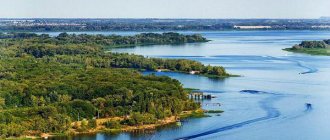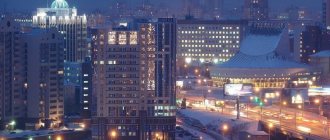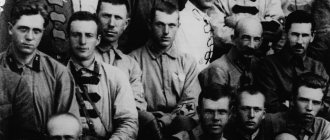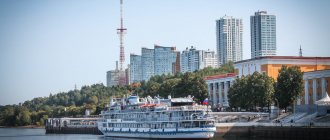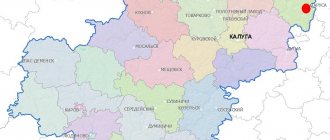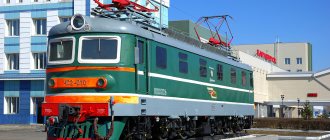Coat of arms of the city of Kolpashevo[1] Emblem used by the administration of the Kolpashevo city (municipal) settlement, 2014. Image from the website of the municipal municipality "Kolpashevo State Enterprise" Kolpashevo city church "Voznesensky Cathedral", 2014. Photo by the press service of the municipal municipality "Kolpashevo urban settlement"
Kolpashevo
- a city in Russia, the administrative center of the Kolpashevo district of the Tomsk region. Port on the Ob River.
It is located in a place just south of the geographical center of the Tomsk region.
See also - object of the same name in Russia
:
Lake Kolpashevo
(9 km north-east of the village of Barguzin, administrative center of the Barguzinsky district, Buryatia).
Dislocation
Geographic coordinates (Yandex.Maps, 2018): 58.311384, 82.902679.
You can get to Kolpashev on the highway “ 69K-2”
» messages “Tomsk - Melnikovo -
Kolpashevo
” (along
the Shegarsky
, then along
the Narymsky
tracts).
A bus leaves from the bus station several times a day, the journey time is 8 hours. The road generally goes along the left bank of the Ob. On the approach to the city of Kolpashevo,
you need to cross the Ob River in the summer by ferry, in the winter along an ice-frozen crossing.
As of 2006, there were 4 ferries (“SP-5”, “SP-11” and two “ramps” (barges pushed by pusher tugs)), which sailed at intervals of half an hour. The ferries belonged to LLC "Pereprava" and LLC "Ferry crossings".[3]. In the demi-season period before the winter freeze-up on the Ob, and also during the spring freeze-up on it? There is a longer detour road to Kolpashevo - through the Verkhneketsky district (the Tomsk - Asino - Pervomaiskoye - Bely Yar - Kolpashevo
).
Climate[edit]
Kolpashevo has a subarctic climate (according to the Köppen climate classification Dfc
) with very cold winters and warm summers. Precipitation is moderate, slightly higher in summer than at other times of the year.
| Climate data for Kolpashevo | |||||||||||||
| Month | Jan | Feb | Mar | Apr | Maybe | Jun | Jul | Aug | Sep | October | But I | December | Year |
| Record high °C (°F) | 3,4 (38,1) | 4,4 (39,9) | 11,0 (51,8) | 24,0 (75,2) | 33,6 (92,5) | 36,1 (97,0) | 35,0 (95,0) | 32,5 (90,5) | 28,9 (84,0) | 21,4 (70,5) | 7,9 (46,2) | 4,6 (40,3) | 36,1 (97,0) |
| Average high °C (°F) | -15,4 (4,3) | -12,6 (9,3) | -3,8 (25,2) | 5,4 (41,7) | 14,1 (57,4) | 21,0 (69,8) | 24,0 (75,2) | 20,2 (68,4) | 13,7 (56,7) | 3,9 (39,0) | -7,3 (18,9) | -14,0 (6,8) | 4,1 (39,4) |
| Daily average °C (°F) | -19,8 (-3,6) | -17,8 (0,0) | -10,0 (14,0) | -0,4 (31,3) | 8,0 (46,4) | 15,2 (59,4) | 18,3 (64,9) | 14,7 (58,5) | 8,5 (47,3) | 0,1 (32,2) | -11,1 (12,0) | -18,2 (-0,8) | -1,0 (30,1) |
| Average low °C (°F) | -24,1 (-11,4) | -22,5 (-8,5) | -15,4 (4,3) | -5,4 (22,3) | 2,8 (37,0) | 9,6 (49,3) | 12,7 (54,9) | 9,9 (49,8) | 4,5 (40,1) | -2,9 (26,8) | -14,8 (5,4) | -22,5 (-8,5) | -5,7 (21,8) |
| Record low °C (°F) | -48,9 (-56,0) | -50,6 (-59,1) | -40,0 (-40,0) | -32,8 (-27,0) | -13,4 (7,9) | -5,0 (23,0) | 2,1 (35,8) | -2,2 (28,0) | -8,5 (16,7) | -28,5 ( -19,3 ) | -48,4 (-55,1) | -49,8 (-57,6) | -50,6 (-59,1) |
| Average precipitation, mm (inches) | 23,1 (0,91) | 16,4 (0,65) | 17,6 (0,69) | 23,6 (0,93) | 47,2 (1,86) | 58,7 (2,31) | 71,6 (2,82) | 72,8 (2,87) | 50,3 (1,98) | 44,8 (1,76) | 35,6 (1,40) | 30,2 (1,19) | 491,9 (19,37) |
| Average number of days with precipitation (≥ 0.1 mm) | 23,8 | 20,0 | 18,2 | 14.0 | 15.3 | 12.0 | 13,5 | 14,9 | 16,5 | 21,6 | 24,8 | 25,7 | 220,3 |
| Average relative humidity (%) | 80,1 | 77,9 | 70,4 | 62,6 | 61,8 | 69,2 | 74,8 | 79,2 | 78,4 | 79,7 | 84,7 | 81,7 | 75,0 |
| Average sunshine hours per month | 54,3 | 109,2 | 175,1 | 226,5 | 260,4 | 300,0 | 308,5 | 243,4 | 150,0 | 83,7 | 52,5 | 37,2 | 2 000,8 |
| Source: climbase.ru [11] | |||||||||||||
Story
The first settlement on the site of the city appeared in the 1670s of the 17th century, when it was founded by the Kolpashnikov
Zaimka, which soon became a village[4].
Initially, the village of Kolpashnikova was assigned to the jurisdiction of the Ket fort.
(Ket district of Tomsk category).
In the 18th-19th centuries the village belonged to the Narym district
Siberian kingdom (Siberian province).
In the 17th - 18th centuries, the routes of Russian embassies to China and the Kamchatka expeditions of Vitus Bering ran through Kolpashevo.
Since 1804, the village of Kolpasheva belonged to the Ket volost
Narym district (Narym region) Tomsk province.
In 1878, Kolpashevo, with the construction of an Orthodox church here, received the status of a village
.
In 1917, the Provisional Government (A. Kerensky) attempted to reorganize the Narym district into the Togur district
.
Since 1920, power in the volosts in the Kolpashevo-Narym territory has been determined by the Kolpashevo district committee of the ruling party RCP(b)
.
Since January 1924, Sibrevkom created a separate Kolpashevo enlarged volost
within the jurisdiction of the district committee of the RCP (b). The village of Kolpashevo becomes the administrative center of the territory for the first time; a volost executive committee, a volost court, a local police department, a military department of the Cheka/OGPU, and a military registration and enlistment office are formed here.
During the period of administrative-territorial zoning
and the liquidation of the previous system of provinces, districts and volosts (a unified Siberian Territory was created), Kolpashevo from August 1925 became the administrative center of the newly created
Kolpashevo district
of the Siberian Territory of the RSFSR (USSR).
Here, re
-formed in the territory: the Kolpashevo district committee of the CPSU(b), the district committee of the Komsomol, the district council and the district executive committee, the district court, the district police department (RKM), the regional department of the OGPU, the district military registration and enlistment office, the district newspaper (agitation and propaganda organ of the district committee of the CPSU(b) with information from the district executive committee). Here are the bodies of primary local self-government: the city committee of the All-Union Communist Party of Bolsheviks, the (village) city executive committee, and other village (city) services.
In 1926, Kolpashevo received the status of a village
, since 1933 -
a workers' settlement
(
urban-type settlement
, urban-type settlement).
In the period 1932 - 1937. Kolpashevo is the administrative center of three levels of government, here are located:
- Kolpashevo City Executive Committee;
- district executive committee of the Kolpashevo district;
- Regional Executive Committee of the Narym District of the West Siberian Territory.
The infamous “Kolpashevsky Yar”, where in 1937 there was the NKVD GULAG (SibLag) district prison.
View in the summer of 2010. Photo from the site Kolpashevo.net. In the photo - st. Dzerzhinsky near the intersection with the street. Lenin. In 1932-1944, Kolpashevo was also the administrative center of the Narym district, the seat of the district administration of special commandant's offices, camps and camps of the system of mass Stalinist repressions "Siblag" (GULAG). Kolpashevsky Yar is notorious, where there is a mass grave of executed and dead repressed people.
At the end of August 1938, Kolpashevo received city
.
In the period 1938 - 1944. Kolpashevo is the administrative center of three levels of government, here are located:
- Kolpashevo City Executive Committee;
- district executive committee of the Kolpashevsky district of the Novosibirsk region;
- Regional Executive Committee of the Narym District of the Novosibirsk Region.
Since 1944, with the re-creation of the Tomsk region
, Kolpashevo has the status of an administrative center of two levels:
- Kolpashevo city administration (1944-1994 - City Executive Committee, since 1994 - city administration);
- Kolpashevo district administration (1944-1994 - district executive committee, since 1994 - administration of the municipal formation "Kolpashevo district"). In the middle of the 20th century, industrial enterprises and enterprises of the local food and agro-processing industries were active. The basis of the industry is timber extraction and wood processing. The Kolpashevo timber industry enterprise of the regional trust "Tomles" operated.
Since 2004, the city of Kolpashevo has been the administrative center of two levels of government:
- center of Kolpashevo district
- center of the Kolpashevo urban settlement (Kolpashevo, Togur village, Volkovo village, Sever village).
Sights of the city of Kolpashevo
The great history of Russia is made up of historical streams, piece by piece collected from the history of all cities, even small ones. They preserve the living, uninterrupted history of Russia in their museums and architectural monuments.
This is a living memory of our ancestors, living pages of national history, our national treasure. Our town is no exception; its rich history is captured in monuments and museums. Historical monuments are carefully protected.
This is how N. Sitnikova writes with love about the city: “I invite you to take a walk around our city, you will see everything that I especially value. There is no closer for me than my native Kolpashevo, I will tell you everything I know about it with love.”
Kolpashevo Museum of Local Lore
The Museum of Local History occupies a worthy place among the museums of the region. To get acquainted with the Kolpashevo district, it is worth visiting the local history museum, which was founded in October 1936. Here you can get acquainted with the nature and history of the region from ancient times to the end of the 20th century. The museum's holdings number over 30 thousand items.
Here we have collected rich material telling about the material and spiritual culture of the population of the north of the Tomsk region - the Selkups, Khanty, Evenks, about the old-timer culture of the Russians, about the history of the development of Siberia and the Narym region by Russian pioneers.
The pride of the Kolpashevo Museum is the collection on the culture of the Narym Selkups (this is the most significant collection of South Selkup objects in Russian museums), the collection of Kulai metal plastics of the 3rd-1st centuries. BC e., a collection of glass negatives by photographer I. S. Fateev, who captured the last moments of the ethnic uniqueness of the Narym Selkups of the 1930s.
The museum has an art collection - works by Tomsk and local artists. The museum's permanent exhibitions are located in 11 halls. Temporary thematic exhibitions are organized in a separate room. Address: st. Lenina, 49.
Church of the Resurrection of Christ in the village of Togur
The oldest Orthodox church in the Narym region (1818) was built on the banks of the Ket River. The basis for the construction of the temple was the revised design of the Peter and Paul Cathedral in Barnaul, the author of which was the Tomsk governor and diocesan architect K.G. Tursky.
The stone walls of the temple, almost a meter thick, rest on a base of tarred larches. The building was erected in the late Siberian Baroque style and has the shape of a tall three-story quadrangle.
The temple is single-domed, pillarless, its facades are decorated with decorative baroque elements. The two-tier bell tower was built according to the “octagon on quadruple” principle. Address: Kolpashevo district, Togur village, Torgovy lane 3.
Ascension Cathedral
The first wooden church in the name of the supreme apostles Peter and Paul in Kolpashevo appeared in 1878 on the high bank of the Ob River near the pier. The church was being rebuilt; it had an unusual architecture, decorated with wooden lace. The church building was crowned with a dome and had seven domes.
In 1932 the church was closed. Currently, a worship cross has been installed at this place in honor of the new martyrs and confessors of Russia. After the closure of the church, there was no church on the territory of the city of Kolpashevo for more than 60 years.
The Ascension Cathedral was erected on the site of the old city administration building. Funds for the construction of the cathedral, which began in 2007, were attracted by the regional public fund “Kolpashevo Church of the Ascension”, specially created in 2004, under the leadership of V.I. Shafrygin.
The first bishop's service in the cathedral under construction took place on April 28, 2013, on the Feast of the Entry of the Lord into Jerusalem. Regular services in the cathedral began in January 2014. Finishing work and improvement of the interior of the cathedral also continued.
On August 24, Bishop Silouan performed the great consecration of the lower chapel of the cathedral. In memory of the pre-revolutionary temple, it was consecrated in honor of the holy supreme apostles Peter and Paul.
The cathedral was consecrated on September 21, 2014, on the Feast of the Nativity of the Blessed Virgin Mary. Metropolitan of Tomsk and Asinovsky Rostislav donated an icon of the Holy Life-Giving Trinity to the temple. Shrines of the cathedral:
- the “Three-Handed” icon of the Mother of God, painted on Holy Mount Athos;
- a particle of the relics of the holy confessor Agafangel (Preobrazhensky);
- ancient icons of saints.
Pupils of the Sunday school of the Ascension Cathedral study the Law of God and the Church Slavonic language, and creative workshops are organized. Address: st. Communist 11.
Monument to those who died for Soviet power
It has been rightly noted that every time has its own heroes and its own monuments. The power of the Soviets immortalized its heroes, the fighters for the establishment of Soviet power in the region, erecting a mass grave and a monument for them on the Pristanskaya Square (1968 - the first monument was created, which has not survived to this day, 1979 - the second, now standing).
During the Soviet years, “fighters for Soviet power in the region” who died from 1921 to 1932 during a difficult, turning point period for our country, during a period when human life was completely devalued by human passions, were reburied in a mass grave from different places.
In the mass grave, which is located on the left side of the upper square of the city pier, seven people are buried: intelligence officers Kostyrev and Pyshkov, one of the first communists Maikov, policeman Lebedev, chairman of the village council Konovalov, commandant Ranek and the head of the enterprise Yurchenko. Seven fir trees were planted near the burial - according to the number of people buried here.
Monument to the fighters for the establishment of Soviet power
The monument to those who died during the formation of Soviet power in the Narym region stands on the high bank, on the pier square; the monument was erected in 1988. The stela depicts a stylized banner.
The monument reminds city residents of the glorious deeds of their ancestors, that their quiet and calm provincial town was also involved in the maelstrom of events of 1917, and their fellow countrymen took an active part in the formation of Soviet power and some died for this just cause.
On November 7, the day of the Great October Socialist Revolution, the city's communists hold rallies here to honor the memory of the fallen heroes of the revolution. Address: Pristanskaya Square on the street. M. Gorky.
Memorial complex dedicated to the Second World War
In the central part of the composition there is a monument to the warrior-liberator. A soldier in a flowing cloak holds a weapon in his right hand and his helmet in his left. On both sides of the monument there are red vertical plates with the names of fellow countrymen who participated in the Great Patriotic War. The inscription on the memorial reads: “Your feat is immortal.”
In front of the monument there is a bowl of the Eternal Flame in the shape of a five-pointed star; the fire is lit on memorable dates during events. The Alley of Heroes leads to the monument, on which there are sculptural busts of five Heroes of the Soviet Union and two full holders of the Order of Glory.
There is no person on earth who would not be touched by the grief of losing loved ones during the Patriotic War of 1941-45. During the Great Patriotic War, thousands of Kolpashevo residents went to the front. Leonid Baginsky wrote:
Honor the memory of the fallen, gentlemen, at least sometimes remember the fallen, gone forever without time, and never break the threads with them.
Home front workers worked hard in the name of victory. For every Kolpashevo resident this place is sacred. On Victory Day, residents of the entire city gather at the monument to honor the memory of their fallen fellow countrymen. Location: Kirova street 15/1.
Monument to V.I. Lenin
In 1960, at the intersection of Lenin and Belinsky streets, a monument to Vladimir Ilyich Lenin was erected. Lenin is one of the greatest thinkers in the history of mankind and the greatest transformative politician in the history of our country.
The intersection of streets forms a small town square in front of the monument. Every year, like several decades ago, on the days of significant dates for the Soviet era, April 22 and November 7, people of the older generation, led by communists, come here.
They come to lay flowers and wreaths to their idol. A man who largely determined the fate of our country for seventy historical years, which included heroic, tragic and joyful events. Location: intersection of Belinsky and Lenin streets.
Kolpashevo city cedar park
In the modern world there are few cities that have forest areas within their boundaries. And we have a city park that is part of the natural taiga. The park area is more than 24 hectares.
During the development process in the 30s of the last century, it was decided to leave a plot of coniferous forest, which is a unique community of different types of forest. A spring flows in the park all year round, to which people come for drinking water.
The flora of the park is represented by coniferous species with a predominance of Siberian pine (cedar), Scots pine, spruce, and fir. Common shrubs include rowan, bird cherry, viburnum, wild raspberry, blueberry, and rose hip. Fauna of the park: squirrel, chipmunk, waxwing, woodpecker, nuthatch, nutcracker, jay, fieldfare, goldfinch.
In the 80s, the park housed a real mini-city garden with attractions: carousels, swings, a Ferris wheel, an autodrome, etc. There was a dance floor, a cinema “Sever” and a branch of the central library. During perestroika, the attractions fell into disrepair and were dismantled, the cinema was demolished, and the library branch ceased operations.
Currently, the territory of the park is in demand by residents for passive and active recreation, including: in winter, hiking and skiing, Nordic walking; in the summer, ecological excursions for children, cycling, walking, Nordic walking, collecting wild plants.
As part of participation in the federal project for the formation of a modern urban environment, the City Administration prepared a design project for the development of a public recreation area “Cedar Park”. The name of the park project was not chosen by chance; more than 500 cedars grow in the park.
For the purpose of comprehensive improvement and expansion of functionality, the project proposed a concept for the development of the park for the period 2017-2020: an area with two playgrounds, an area with two sports grounds (skateboard park, weight training equipment), a quiet recreation area.
There is also an area with a comprehensive sports ground (volleyball, basketball, mini-football), an area for holding public events (stage, shed for holding master classes, pavilions), and an area for jogging and cycling paths.
A huge amount of work has been done, and the park is taking on the outlines of its plans. The total cost of the project is 43 million rubles. “Cedar Park”, after the implementation of the project, will create a modern and effective place for mass recreation and improve the quality of life of Kolpashevo residents. Address: st. Parkovaya street 2.
Modernity
On February 20, 2008, the 50-kilometer gas pipeline Chazhemto - Kolpashevo[5] was put into operation, which will make it possible to gasify the city’s boiler houses. Construction was supposed to be completed in November 2007[6], but the deadlines were delayed, and the initially estimated cost of the gas pipeline increased by 500 million rubles (to 1.7 billion rubles).[7].
The newspaper “Soviet North” is published three times a week. There is a “Television Studio Kolpashevo “TVK””, which has also been broadcasting radio broadcasts “Avtoradio-Kolpashevo” since November 16, 2010.
The city has a modernly equipped Kolpashevo Central District Hospital.
In September 2022, a decision was made to establish a chapel-monument to the victims of political repression in the city of Kolpashevo. On September 21, 2022, the foundation stone of the chapel will be laid and consecrated on the territory of the Kolpashevo Ascension Cathedral.
Demography
Demographic dynamics of the resident population of Kolpashevo by year[8]:
- 1897 - approx. 700 people;
- 1911 - approx. 600 people;
- 1926 - approx. 1400 people;
- 1939 - approx. 15200 people;
- 1959 - approx. 22600 people;
- 1979 - approx. 28,600 people;
- 1989 - approx. 31,300
people; - 1996 - approx. 29,700 people;
- 2003 - approx. 28,400 people;
- 2007 - approx. 25800 people;
- 2010 - 24,124 people;
- 2012 - 23,499 people;
- 2014 - 23,073 people;
- 2016 - 23,127 people;
- 2018 - 23180 people
Economy
About 300 enterprises in the production and non-production sectors of the economy are registered.
The most famous enterprises:
- Kolpashevo fish processing plant
- Kolpashevo shipyard
- Kolpashevsky
- Kolpashevo meat processing plant
- Kolpashevo poultry farm
- LLC "Kolpashevskaya Mineral Water"
- Kolpashevo State Breeding Station
- Kolpashevo gas exploration expedition
- CJSC "Tomsk Geophysical Trust"
- Kolpashevo Command and Measuring Complex (OKIK-12) of the Russian Military Space Forces (military unit 14174)
- Kolpashevo river port
- Kolpashevo Airport
- Air
Yar and pier in the village of Kolpashevo. End of the 19th century. Painting by artist P.M. Kosharova. Photo by the press service of the municipal municipality "Kolpashevo urban settlement"
Literature and sources
- Anthropology of terror. Yar // Historical and humanistic project of video materials from the TV-2 news agency about the events of the Gulug period in the Narym district. - Tomsk, 2022. - Electronic resource
: tv2.today/Istorii. - Rassamahin Yu.K.
Kolpashevo // Encyclopedia of the Tomsk Region, Volume 2: “N - I”.
- Tomsk: Tomsk University Publishing House, 2009. - pp. 311-312. — ISBN 978-5-7511-1917-1 — Electronic resource
: vital.lib.tsu.ru. - Sergeeva N.Ya., Efimova E.M.
Kolpashevo [source essays].
- Novosibirsk, 1982. Sergeev N.Ya., Efimova E.M.
Kolpashevo. / Ed. 2nd. - Tomsk: Tomsk Book Publishing House, 1987. - 64 p., ill.
Notes
- The coat of arms of a territory of the second category (county, district, district in the USSR and the Russian Federation), consisting of a larger administrative-territorial entity with the rights of a subject of power (province, territory, region) consists of a heraldic field divided into two parts: in the upper part there is a heraldic symbol of the province, in the lower part the emblem, symbol of the county, district. The district coat of arms is crowned with a county (district) crown, which has pointed ends. The coat of arms of the administrative center of a territory of a county or district type repeats the coat of arms of the territory, but is crowned with a city crown, which differs from the county crown. The coat of arms of Kolpashevo is based on the emblem-symbol of Kolpashevo, specially designed by order of the district administration by a group of Moscow designers and adopted by the district as the main distinctive symbol in 2008-2010. the description of the sign of the district symbol (emblem, base of the coat of arms) reads: ... “In a green field there is an overturned silver fork-shaped cross, burdened with a scarlet ball, burdened with a golden sun with flaming rays.” (Administration of the Kolpashevo district, 2009-2011). The upper half of the heraldic shield bears the emblem of the heraldry of the Tomsk region (Tomsk province): in a green field there is a silver fighting strong rearing horse. The symbolism of the coat of arms should be understood and read as follows. The coat of arms of the Kolpashevo district (and the city) reflects the historical, economic, and natural features of the Kolpashevo district.
Colors and symbols indicate: Fork-shaped cross - 2 main waterways of the Kolpashevo district artery: the Ob and Ket rivers; The sun is the personification of vitality and love, as well as wealth and abundance (in our case, the natural resources of the Kolpashevo district); Silver - symbolizes nobility, frankness, as well as purity, innocence and truthfulness. In medieval astronomy, silver corresponded to the element - water; Gold - faith, justice, mercy, wealth, rebirth; Chervlen (red) – strength, courage, courage, love; Greenery (in our case - forest, meadow grass). Main idea: “Kolpashevo district belongs to the group of northern districts of the Tomsk region, in the central part of which it is located. The Ob River crosses the territory of the region from southwest to northeast almost in the middle and is its main waterway. The area is rich in forests, water resources, and a number of minerals. On the territory of the region there is a section of the huge Ob-Yenisei waterway, which ran along the Ob and Ket rivers. Kolpashevo district is located in the southeastern part of the West Siberian Plain . - VGTRK TV Tomsk (09/03/2018, photo report): Celebration on a grand scale: Kolpashevo celebrated its 80th anniversary.
- Transport Travelers Forum - Friday, August 18. Down the Ob.
- A village
is a settlement with a number of houses (family farmsteads) ranging from a minimum of three to a maximum of more than two hundred houses, without the presence of a church (temple) in such a settlement.
The presence of a temple in a settlement in the Russian tradition at least transfers it to the status of a village
.
The predominant occupation of village residents is agriculture and crafts, which distinguishes a village from a village
, where workers live near the village-forming enterprise. - Kolpashevo was gasified with minimal budget participation
- Kolpashevo: territory of change. One district of the Tomsk region was included in Gazprom’s gasification program
- Investments in the Chazhemto-Kolpashevo gas pipeline in the Tomsk region amounted to 1.7 billion rubles, the governor said.
- "Encyclopedia of the Tomsk Region", page 311.
- In Kolpashevo it is necessary to build a new channel of the Ob
Conclusion
Today the city of Kolpashevo is going through hard times. But the resource potential of the Kolpashevo district is very significant. As already mentioned, natural resources and vast areas of land make it possible to begin the revival of agricultural production for business development.
There is no corner on earth that does not attract attention. Our small Siberian town is beautiful with its unique history and natural beauty. Those who visit our hospitable town will certainly remember: the spreading poplar greenery, the calm measured life of the streets, the amazing, unique beauty of the mighty Ob River.
It makes sense to visit here, get acquainted with the unique nature and historical monuments. See with your own eyes the charm of our city. Here’s how Valentina Kudryavtseva soulfully writes about this feeling:
From our ancient past, the mountain ash city of Kolpashevo, on the high Ob bank, fled and froze in its flight.
Welcome to Kolpashevo land! I sincerely hope that this acquaintance with the life and history of our region will be a pleasant event for you. Write comments, I will be glad to communicate.
Links
- Ancient (19th century) symbol of Kolpashevo and Narym region (photo No. 9 of a fragment of the city museum building), 2012
- Official website of the Kolpashevo district administration
- Newspaper Kolpashevskaya
- Information portal of Kolpashevo
- Unofficial site of Kolpashevo
- Photo report about the city of Kolpashevo
- Kolpashevo Museum of Local Lore
- Monitoring the state of atmospheric air in Kolpashevo
- Kolpashevo City Forum
- Map of Kolpashev in Google (traffic)
- Weather in Kolpashevo - weather forecast for 10 days
- Local history pages on the Tomsk Review portal. Kolpashevo: a city on the right bank (02/25/2014)
- Photo report from the city Ob ferry (autumn 2014)
58°18′21″ n. w. 82°54′23″ E. d. / 58.305833° s. w. 82.906389° E. d. (G)58.305833, 82.906389
| Administrative division of the Tomsk region | |
| Cities of regional subordination: Kedrovy, Seversk, Strezhevoy, Tomsk | |
| Cities of district subordination: Asino, Kolpashevo | |
| Districts (administrative centers in brackets): | |
|
|
Interesting Facts
– In the XVII – XVIII centuries. along the great water road that ran along the Ket River, the routes of the embassies of the Russian tsars to China and the famous Kamchatka expeditions led by Bering and Chirikov ran.
– At the beginning of the 20th century, Kolpashevo turned into one of the largest colonies of Narym political exile. Representatives of various political parties were installed here “under the open supervision of the police.” The most famous of them: Ya. M. Sverdlov, I. N. Smirnov, A. V. Shotman, F. I. Goloshchekin, M. M. Lashevich.
– Industrial facilities, administrative buildings, and residential buildings were built by the hands of exiles in Kolpashevo. Some of them, along with peasant huts of the last century, have survived to this day. Among others, the famous Russian poet N.A. Klyuev served his exile in Kolpashevo.
– A powerful stream of Russian settlers was moving along the Ket River, exploring new lands. Some of them, having stayed, settled in Kolpashevo and its environs, founded new settlements, calling them by their own names.
